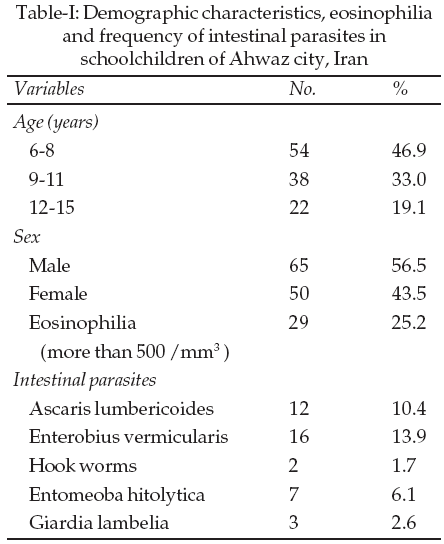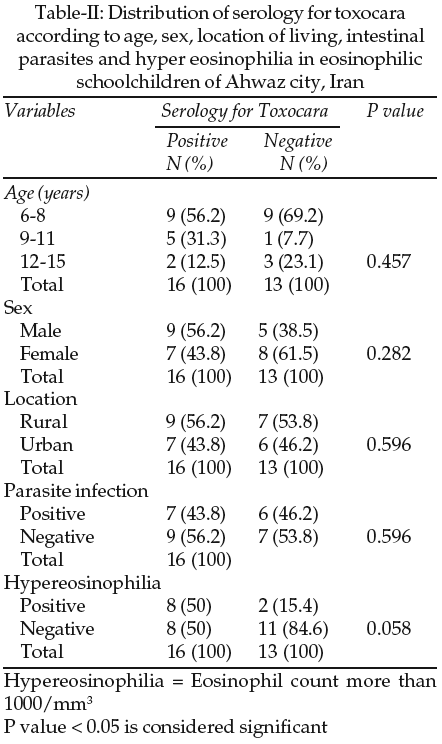|
|
||||
|
Published by : PROFESSIONAL MEDICAL PUBLICATIONS |
||||
|
ISSN 1681-715X |
||||
|
||||
|
- |
||||
|
ORIGINAL ARTICLE |
||||
|
- |
||||
|
Volume 24 |
April - June 2008 (Part-II) |
Number 3 |
||
|
|
||||
|
|
||||
|
|
||||
|
Published by : PROFESSIONAL MEDICAL PUBLICATIONS |
||||
|
ISSN 1681-715X |
||||
|
||||
|
- |
||||
|
ORIGINAL ARTICLE |
||||
|
- |
||||
|
Volume 24 |
April - June 2008 (Part-II) |
Number 3 |
||
|
|
||||
|
|
||||
Frequency of anti Toxocara antibodies in school
children with chronic cough and eosinophilia in Ahwaz, Iran
Seyed Mohammad Alavi1, Gholamhossein Sefidgaran2
ABSTRACT
Objectives: To determine the seroprevalence of Toxocara in children having chronic cough.
Methodology: It is a cross sectional study conducted at Ahwaz a city southwest Iran, from Sep 2006 to Dec 2006. Analyses were based on 115 children (randomized cluster sampling) with chronic cough (cough with duration of 2 weeks or more). Laboratory exams; CBC, eosinophils absolute count and tests for intestinal parasites were performed. Eosinophils >500/mm3 were considered as eosinophilia. IgG anti-toxocara antibodies test was carried out by ELISA method for eosinophilic child.
Results: Out of total 115 children 29(25.2) were eosinophilic, among them 10(34.48%) hypereosinophilic and 40 (34.78%) had intestinal parasites. Frequency of Toxocara-IgG in chronic cough, eosinophilic and hypereosinophilic was 13.9%, 55.2% and 80% respectively.
Conclusions: Chronic cough associated eosinophilia among children in Ahwaz may be contributing to Toxocara infection.
KEYWORDS: Chronic cough, Anti-toxocara antibodies, Eosinophilic, Ahwaz.
Pak J Med Sci April - June 2008 (Part-II) Vol. 24 No. 3 360-363
How to cite this article:
Alavi SM, Sefidgaran G. Frequency of anti Toxocara antibodies in schoolchildren with chronic cough and eosinophilia in Ahwaz, Iran, 2006. Pak J Med Sci 2008;24(3):360-3.
1. Seyed Mohammad Alavi, MD
Joundishapoor Infectious and
Tropical Diseases Research Center,
2. Gholamhossein Sefidgaran, MS
Management Department of Health College,
1,2: Joundishapour University of Medical Sciences,
Ahwaz - Iran.
Correspondence
Dr. Seyed Mohammad Alavi, MD
Email: alavi1329dr@yahoo.com
* Received for publication: June 23, 2007
* Revision Received: March 17, 2008
* Revision Accepted: March 19, 2008
INTRODUCTION
Toxocariasis is a widespread native parasitosis. It is due to the presence of Toxocara-type nematode larvae in the organism that is at the origin of various clinical pictures.
1 Transmitted by dogs and more rarely by cats, contamination occurs by ingestion of embryos deposited on the ground.2 The clinical forms are non-specific but frequent and varied: neurological, ophthalmologic, pulmonary, cutaneous and sometimes rheumatological.3 It has been found that the parasitic infection prevalence varies widely in the globe and even within a single country, due to its epidemiological characteristics.4-6 Chronic eosinophilic pneumonia, a sub acute onset of cough, dyspnea, fever and weight loss associated with peripheral eosinophilic may be due to various infectious agents such as Toxocara.3 In many Iranian regions particularly in the southwest area such as Khuzestan, one should expect to find a higher prevalence than those reported in other countries. There are few epidemiological studies carried out on this subject in Khuzestan and even in Iran.7 Chronic cough is a common pediatric problem in Khuzestan, majority of them are currently treated as bronchial asthma and there are some questions about the role of Toxocara infection in this medical condition,5 thus an accurate estimation of the prevalence of Toxocariasis can lead to effective management. The present study was done in order to determine the seroprevalence of Toxocara in children having chronic cough.METHODOLOGY
A cross sectional study was carried out on schoolchildren during a tuberculin survey in Ahwaz city in Khuzestan province southwest Iran from September 2006 - December 2006. The sample studied (randomized cluster sampling) consisted of 4206 children. Among them children having chronic cough (cough with duration of two weeks or more) other than tuberculosis were asked to refer to infectious diseases clinic for further evaluation. One hundred fifteen children were enrolled and routine laboratory exams performed included CBC (complete blood count) eosinophils absolute count and tests for intestinal parasites. Values above 500 eosinophils/mm3 and 1000 eosinophils/mm3 were considered as eosinophilia and hypereosinophilia respectively.
3,4,8 Eosinophilic Childs were tested for anti toxocara antibodies. IgG anti-toxocara antibodies test was carried out by ELISA method, using secretary and excretory antigens from second stage larvae cultured in vitro.1,3,8,9 All sera were tested by standard method to avoid cross reaction between Toxocara antigen and Ascaris antibodies.9 A questionnaire including demographic data, location of living site and related variables was used for each child. Descriptive analysis was carried out to verify the frequency of anti-toxocara antibodies in the total sample according to gender and age, Pearson chi square and fisher exact tests were also used for comparison and p value <0.05 was considered statistically significant.RESULTS
Out of total 4206 children 146 (3.47%) had chronic cough. Three children with tuberculosis and twenty eight because of discontinuation were excluded. Finally 115 children enrolled in this analysis. Demographic characteristics, eosinophilia and frequency of intestinal parasites are described in Table-I.

Out of total 115 children 29(25.2) were eosinophilic, among them 10 (34.48%) presented with hypereosinophilia. Intestinal parasites were detected in 40 (34.78%) of those 10% were eosinophilic, none of them were hypereosinophilic. Only 16 children (13.9%) had anti Toxocara antibodies. Frequency of anti Toxocara antibodies in eosinophilic was 55.2% whereas in hypereosinophilic was 80%. The anti body frequency among male was 56.3% while in females it was 43.7%. Table-II describes distribution of serology for Toxocara according to gender, age, site of living and intestinal parasites.

DISCUSSION
In this study we determined frequency of Toxocara antibody in schoolchildren having chronic cough and eosinophilia, so this study doesn’t reflect real prevalence in the population of Ahwaz. Since the presence of peripheral eosinophilia is one of the laboratory criteria for presumed Toxocara infection,
3 it should be stated that the present sample population had a greater chance of having anti Toxocara antibodies.Present study showed that frequency of anti Toxocara antibody is 13.9% that is lower than that described by Sajjadi et al
10 with 25.6% in Shiraz (Iran), Santos et al4 with 39% in Brazil and Hayashi et al11 with 84.6%. There are several factors that make it difficult to compare this study with others, such as small number of children having Toxocara antibody and design of study (limited to eosinophilic patients with chronic cough). However, religious behaviors in Moslem that forbid them of close contact with dogs may contribute to low frequency of seroprevalence of Toxocariasis in Iran. Ahwaz city is considered to be an endemic area for intestinal parasites, which may have cross reactivity to toxocara.7 However, present data (Table-II) discarded a correlation between the presence of intestinal nematodes and anti Toxocara antibodies (p>0.05). In this study there was no significant gender difference in Toxocara antibody, that is consistent with Sajjadi et al and Santos et al reports.4,10Our study presents no significant age difference in Toxocara antibody frequency (p>0.05) that was consistent with Sajjadi et al report
10 but, different from that of Santos et al4 who showed significant age difference. All previous reports described the highest seropositivity of Toxocara in hypereosinophilic.3,4,8,12,13 Although in our study the highest seropositivity was also found in hypereosinophilic, but statistically it is not significant (P>0.05), this paradox may be due to small sample size of studied population in our study and should be re-evaluated in further studies. In the present study we found that Toxocara seroprevalence in rural and urban communities are similar (P>0.05), this finding is different from studies by Hyashi11 and Jones14 in rural and urban area with toxocara antibodies frequency of (84.6% vs 12.2%) and (54% vs 23.1%). Although frequency of ownerless dogs in rural area of Iran is considerable but, due to Islamic beliefs (dog as dirty animal) human closed contact with dogs are unremarkable and consequently people living in this area are not easily infected with T.canis.CONCLUSIONS
This study shows that chronic cough associated eosinophilia among children in tropics may be contributing to Toxocara infection. Intestinal parasites are not associated with hypereosinophilia.
Recommendation:
1. Seroepidemilogical investigation should be carried out in large scale in Khuzestan.
2. In area with scarcity of serology laboratory facilities, children with chronic cough and eosinophilia (especially hypereosinophilia) should be regarded as Toxocariasis and treated with anti Toxocara drugs.
3. In area with high prevalence of eosinophilia, prevent T.canis eggs contaminating the environment and children from ingesting eggs (pica). Dogs should be periodically treated for T. canis.
ACKNOWLEDGMENT
The authors wish to thank the chief and personnel of Jondishapoor Infectious and Tropical Research Center for supporting of this study. We also acknowledge Dr. Seyed Mohammad Reza Alavi for assistance in statistical analysis.
REFERENCES
1. Welter PE. Trichinella and other tissue nematodes. In: Kasper, Braunwald, Hauser, Lango, Jameson. Harrison’s Principles of Internal Medicine.16th Ed. New York: McGraw-Hill 2005;150:1253-6.
2. Degouy A, Menat C, Aubin F, Piarroux R, Woronoff-Lemsi MC, Humbert P. Toxocariasis. Press Med 2001;30(39):1933-8.
3. Nash TE. Visceral Larva Migran and other unusual helminthes infection. In: Mandell, Douglas, Bennett. Principles and Practice of Infectious Diseases. Sixth ed. Philadelphia: Churchill Livingstone 2005;3293-9.
4. Aguiar-Santos AM, Andrade LD, Medeiros Z, Chieffi PP, Z Lescano SZ, Perez EP. Human toxocariasis: Frequency of anti-Toxocara antibodies in children and adolescent from an outpatient clinic for lymphatic filariasis in Recife, northeast Brazil. Rev Inst Med Trop S Paulo 2004;46(2):81-5.
5. Buijs J, Borsboom G, Gemund JJ. Toxocara seroprevalence in 5-year-old elementary school children: relation with allergic asthma. Amer J Epidem 1994;140:839-47.
6. Genchi C, Di Sacco B, Gatti S, Sangalli G, Sscaglia M. Epidemiology of human toxocariasis in northern Italy. Parassitologia 1990;32:313-9.
7. Nazaripooya MR. Helminth induced diseases. In: Azizi F, Hatami H, Janghorbani M. Epidemiology and control of prevalent diseases in Iran.1st ed. Tehran: Nashre eshtiagh 2000;387-411.
8. Holand SM, Gallin JI.Diseases of granulocytes and monocytes. In: Kasper, Braunwald, Hauser, Lango, and Jameson. Harrison’s Principles of Internal Medic- ine.16th Ed. New York: McGraw-Hill 2005;1:349-57.
9. De Savigny DH, Volier A, Woodruff AW. Toxocariasis: serological Diagnosis by enzyme immunoassay. J Clin Path 1979;32:284-8.
10. Sadjjadi SM, Khosravi M, Mehrabani D, Orya A. Seroprevalence of toxocara infection in school children in Shiraz, Southern Iran. J Trop Pediatr 2000;46(6):327-30.
11. Hayashi E, Tuda J, Imada M, Akao N, Fujita K. The high prevalence of asymptomatic Toxocara infection among schoolchildren in Manado, Indonesia. Southeast Asian J Trop Med Public Health 2005;36(6):1399-406.
12. Beaver PC. Toxocarosis (Visceral larva migrans) in relation to tropical eosinophilia. Bull Soc Path Exot 1962;55:555-76.
13. Taylor MR, Keane CT, O’Connor P, Mulviehill E, Holland C. The expanded spectrum of toxocaral disease. Lancet 1988;26:692-95.
14. Jones WE, Schantz PM, Foreman K. Human toxocariasis in a rural community. Am J Dis Child 1980;134:467-76.
HOME | SEARCH | CURRENT ISSUE | PAST ISSUES
Professional
Medical Publications
Room No. 522, 5th Floor, Panorama Centre
Building No. 2, P.O. Box 8766, Saddar, Karachi - Pakistan.
Phones : 5688791, 5689285 Fax : 5689860
pjms@pjms.com.pk